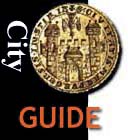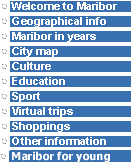 Mladinska
street
Mladinska
street
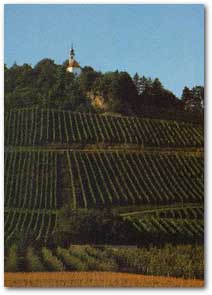 From
Strossmayerjeva ulica we return west and proceed along Mladinska
ulica and Vrbanska cesta. At the beginning
of the chestnutlined promenade, we turn north and follow the second treelined
avenue towards Kalvarija (Calvary
Hill), where the College of Agriculture (Vrbanska 30) and Technological
Agricultural School are located. At Vrbanska 32/a an engineering secondary
school, a tree-nursery, vineyards, and a farming area are located. On our
return along the promenade, we turn east at Vrbanska cesta. To our
left are the orchards and vineyards on the slopes of Kalvarija (Calvary
Hill) As we walk along Vinarska ulica, at number 14, we find the
Agricultural Institute, which disseminates information on the care and advancement
of fruit and wine production. From Vinarska ulica we return to Mladinska
and continue east. The Elementary School Bojan Ilich, built in 1908, is
to our right, at number 13. It was once a teacher' training school, and
continued in this capacity for several years after World War II. The building
next to it now houses the Faculty of Law . It was built in 1892 as
a secondary school (Gymnasium). A bust of Henrik Schreiner (1850-1920),
a director of the teachers' college and a distinguished Slovene educator,
stands on a marble pedestal between the teachers' training school and the
Law Faculty. The bust was sculpted by Gabrijel Kolbic.
From
Strossmayerjeva ulica we return west and proceed along Mladinska
ulica and Vrbanska cesta. At the beginning
of the chestnutlined promenade, we turn north and follow the second treelined
avenue towards Kalvarija (Calvary
Hill), where the College of Agriculture (Vrbanska 30) and Technological
Agricultural School are located. At Vrbanska 32/a an engineering secondary
school, a tree-nursery, vineyards, and a farming area are located. On our
return along the promenade, we turn east at Vrbanska cesta. To our
left are the orchards and vineyards on the slopes of Kalvarija (Calvary
Hill) As we walk along Vinarska ulica, at number 14, we find the
Agricultural Institute, which disseminates information on the care and advancement
of fruit and wine production. From Vinarska ulica we return to Mladinska
and continue east. The Elementary School Bojan Ilich, built in 1908, is
to our right, at number 13. It was once a teacher' training school, and
continued in this capacity for several years after World War II. The building
next to it now houses the Faculty of Law . It was built in 1892 as
a secondary school (Gymnasium). A bust of Henrik Schreiner (1850-1920),
a director of the teachers' college and a distinguished Slovene educator,
stands on a marble pedestal between the teachers' training school and the
Law Faculty. The bust was sculpted by Gabrijel Kolbic.
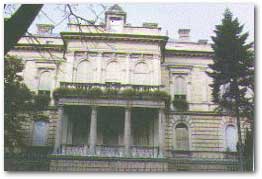 The Secondary School of Music and Ballet is across the
street, at Mladinska 12. Built in 1877, it was originally intended as a
theological seminary. Many Slovene intellectuals received their early education
there, among them Dr. France Kidric, Dr. Joza Glonar, Dr. Janko Slebinger,
and Vladimir Levstik. Muzej
narodne osvoboditve (the Museum of National Liberation) [24] is at the
corner of Mladinska and Ulica heroja Tomsica. In the past it had
served a variety of functions: at first it was a villa owned by a merchant
named Scherbaum; during World War I, it housed the Austrian-Hungarian Supreme
Command in its war against Italy. in the 1920s, it was used as an adminitration
centre for the Maribor government; from 1930 on, it was a school of forestry;
and after World War II, a headquarters for various political organizations.
The Secondary School of Music and Ballet is across the
street, at Mladinska 12. Built in 1877, it was originally intended as a
theological seminary. Many Slovene intellectuals received their early education
there, among them Dr. France Kidric, Dr. Joza Glonar, Dr. Janko Slebinger,
and Vladimir Levstik. Muzej
narodne osvoboditve (the Museum of National Liberation) [24] is at the
corner of Mladinska and Ulica heroja Tomsica. In the past it had
served a variety of functions: at first it was a villa owned by a merchant
named Scherbaum; during World War I, it housed the Austrian-Hungarian Supreme
Command in its war against Italy. in the 1920s, it was used as an adminitration
centre for the Maribor government; from 1930 on, it was a school of forestry;
and after World War II, a headquarters for various political organizations.
The promenade through the
Town 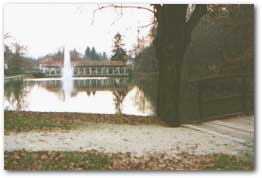 Park
begins across the road. At the entrance is a square-shaped monument, carved
from grey marble and dedicated to the combatants for the northern border.
It is the work of the sculptor Drago Trsar. The promenade, lined
with nicely spaced flower beds and unobtrusive lampposts, was designed by
the architect Ljubo Humek. It runs between the old and the new parts of
the park towards the tastefully designed area of the Trije
ribniki ("The Three Ponds"). To the left there is a children'
s playground, with a small pool and fountain; situated before the first
pond, is a well known restaurant.
Park
begins across the road. At the entrance is a square-shaped monument, carved
from grey marble and dedicated to the combatants for the northern border.
It is the work of the sculptor Drago Trsar. The promenade, lined
with nicely spaced flower beds and unobtrusive lampposts, was designed by
the architect Ljubo Humek. It runs between the old and the new parts of
the park towards the tastefully designed area of the Trije
ribniki ("The Three Ponds"). To the left there is a children'
s playground, with a small pool and fountain; situated before the first
pond, is a well known restaurant.
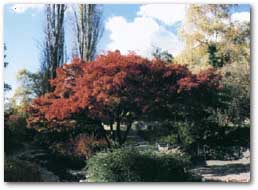 The
Town Park east of the promenade was planted with trees in 1872; and during
1889-1896, trees were planted in the newer section west of the promenade.
The park area had remained unchanged until the present day. In 1890, the
large gazebo, where musical festivities are held, was erected. Since 1953
the Town Aquarium [25], Ulica heroja Staneta 19, occupies a former coffee
house, constructed before World War II.
The
Town Park east of the promenade was planted with trees in 1872; and during
1889-1896, trees were planted in the newer section west of the promenade.
The park area had remained unchanged until the present day. In 1890, the
large gazebo, where musical festivities are held, was erected. Since 1953
the Town Aquarium [25], Ulica heroja Staneta 19, occupies a former coffee
house, constructed before World War II.
The Town Park has many exotic trees and bushes;
the trees are conveniently tagged. The Park boasts some 99 different species
of trees. The entire Park underwent a careful refurbishing to commemorate
its 100th anniversary. Maribor takes great pride in this lovely park. The
eastern corner of the Park leads into Ulica heroja Staneta.
©Rain
